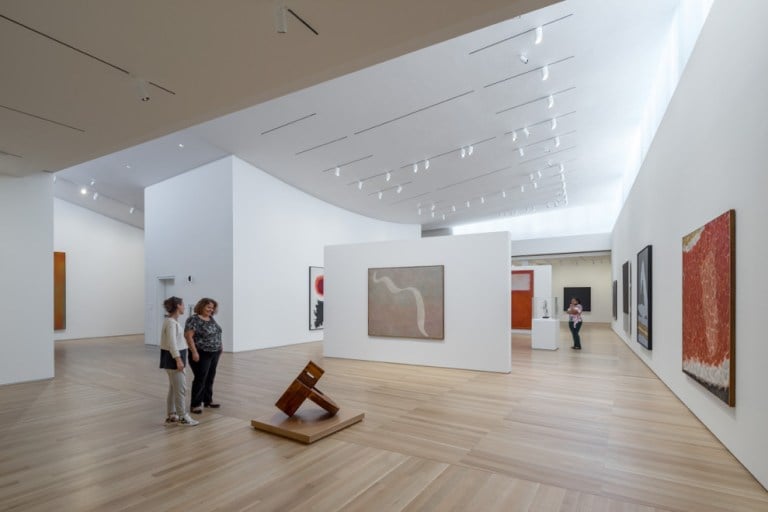The Anderson Collection recently welcomed an additional 11 artworks by Manuel Neri and a painting by Mary Weatherford to the museum, just after receiving Bill Jensen’s watercolor and gouache Study for Denial at the end of 2016.
Mary Weatherford’s Black Painting—gifted by Debra and Steven Wisch ’83, whose Wisch Family Gallery is located on the first floor of the Anderson Collection—was the first of her works installed in the collection, along with three drawings on paper by Manuel Neri—gifts from the artist’s trust.
Jason Linetzky, director of the Anderson Collection, was delighted to see positive reactions to the new pieces of art from visitors.
“We are just starting to get that campus reaction now with the announcement,” Linetzky said. We certainly see a lot of visitors spending time looking at the Weatherford’s Black Painting and talking with each other about it.”
After the opening of the museum, prospective donors presented artwork to the Anderson Collection, which has an approval and review process for acquiring new works.
“The first two years of our existence was dedicated to sharing the collection almost exclusively with the public and with the Stanford community to make sure we introduce properly the family’s gift,” Linetzky said. “We saw an increase in interest from many people in the community to think about how the collection might be able to grow.”
During the selection process, the artwork is expected to be consistent with the type of art presented at the Anderson Collection. The focus of the collection is grounded in modern and contemporary American art with concentration in New York and California.
According to Linetzky, the Bill Jensen work on paper Study for Denial—a preliminary, working study for the oil on canvas painting—directly relates to Denial, 1983-86 a painting already in the Andersons’ original collection. (Jensen later produced Etching for Denial, 1986-88 demonstrating his continued interest in this composition. That work is not in the museum’s collection but does belong to the Anderson family.)
Similarly, the three additional sculptural works by Manuel Neri relates to his work in the original collection from the Andersons: a plaster sculpture of a standing figure on the second floor in the Bay Area Figurative Gallery.
“Gifting us eight art pieces on paper by Neri [allows] us to offer a deeper understanding of his works since his work on paper is something we haven’t had in our collection before,” said Aimee Shapiro, director of programming and engagement. “His three sculptural reliefs we received also provide a more in-depth way [of] looking at an individual artist and his process.”
Linetzky shares a similar perspective that bringing in the additional works by Neri allows the museum to add both more depth and breadth through the artist’s consistent style with the museum and the way he works across different materials.
“Our hope is that we are always home for the Anderson family’s gifts, but that at the same time we are able to keep the collection dynamic both through exhibition as well as addition to the collection,” Linetzky said.
Even though Mary Weatherford is “totally new” to the Anderson Collection, she has several connections to Stanford through her grandmother, grandfather and mother, all of whom are alumni of the University. This fact, in Linetzky’s opinion, made the presence of her work at Stanford all the more inspiring.
Shapiro is grateful for Steven and Debra Wisch for being “big supporters of the arts at Stanford” and for gifting Weatherford’s painting, as the Collection is working to incorporate more contemporary works. Weatherford, an established and well-known contemporary artist, is influenced by different movements presented in the Anderson collection.
The new thirteen artworks are the first gifts the museum has received since the opening of the Anderson Collection, and the move to expand the collection has been growing ever since.
“As part of opening some real doors and opportunities for the museum, we hope to further expand the reach and what the museum can provide to not only the campus community but also the local community and the art world,” Shapiro said.
The Anderson Collection staff intends for the museum to be a place that welcomes all types of visitors, regardless of their level of understanding of contemporary or modern American art.
“The collection is continuing to evolve in a way that allows us to both share the collection with the community and have the community respond to it,” Linetzky said.
Contact Elicia Ye at eliciaye ‘at’ gmail.com.
